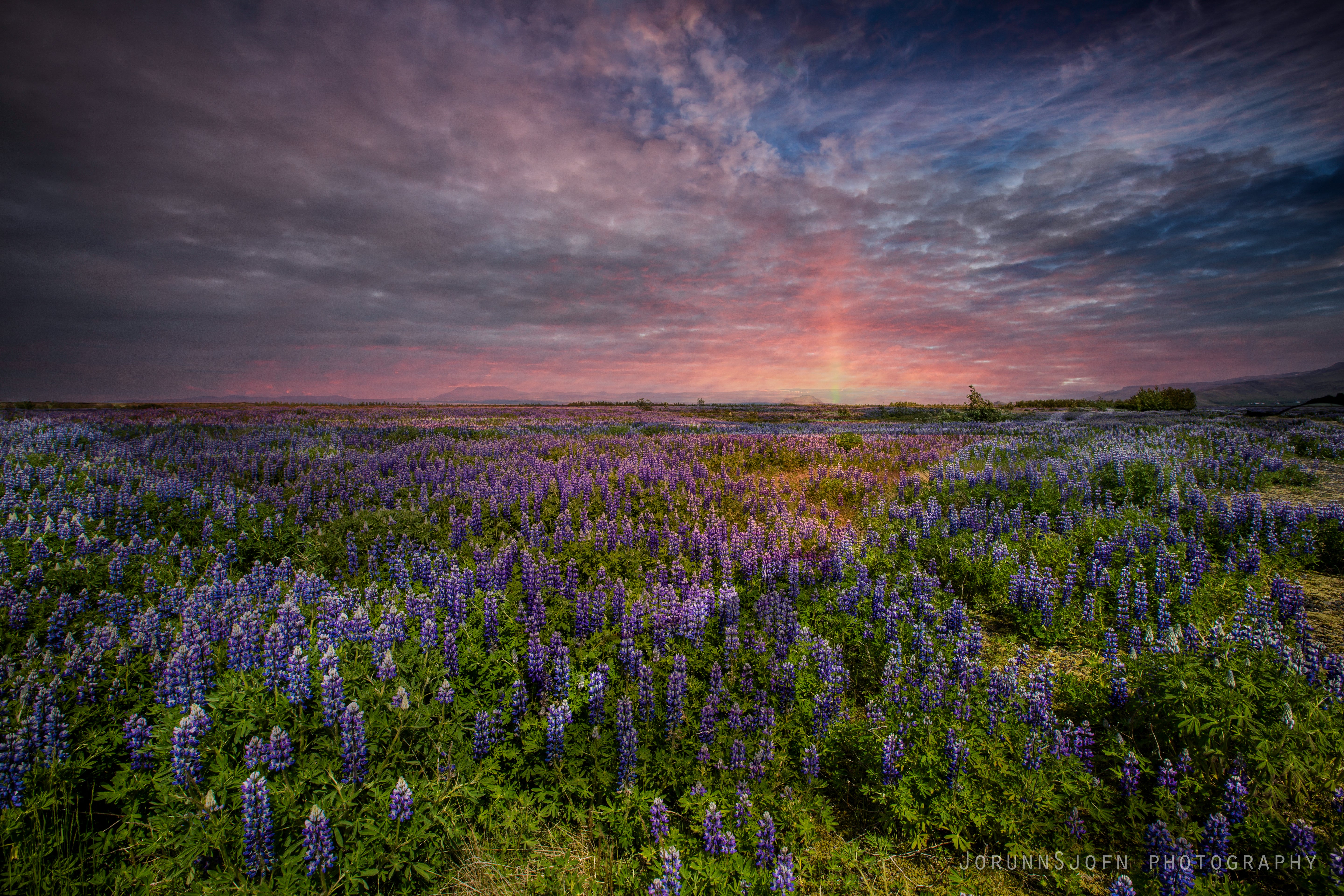
Látravík and Breiðavík are well-known coves in the Westfjords of Iceland, but both of them belong to the Útvikur coves.
Many people will for sure have heard about Látrabjarg, the largest seabird cliff in my country in the vicinity, which is the best place to photograph a puffin in Iceland.
I have shown you both Látrabjarg, Látravík, and Breiðavík in my travel-blogs, but there is yet another cove that belongs to the Útvíkur coves, the remote and beautiful Kollsvík cove.
Top photo: one of the turf outhouses in Kollsvík

Hænuvík - Patreksfjörður village in the distance
You will meet many visitors at Látrabjarg, but fewer people visit Kollsvík. To reach this beautiful cove you will have to drive on top of a mountain for a while. And it is so rewarding as the view is amazing.
Kollsvík is on the southernmost and westernmost peninsula of the Westfjords, which separates Patreksfjörður and Breiðafjörður fjords.
And Kollsvík is the northernmost cove of the 3 Útvíkur coves. Útvíkur coves stretch from Blakknes all the way to Bjargtangar. A very interesting part of the Westfjords.

A cairn on the top of the mountain - the old GPS in Iceland
Along the way, you will see Hænuvík on your right-hand side by the sea. Keep on driving on Hænuvíkurháls, from which there is a fantastic view as we will be driving as high as 320 meters.
This is an old thoroughfare, but the gravel road was built in 1953.
We stopped by a cairn on the top to have a look at the beautiful view. And again we had a great view when we drove down from the mountain and into Kollsvík cove.

Kollsvík - the old turf outhouse and Láginúpur farm
What I noticed at Kollsvík was how well everything was marked, there were information signs in so many places. I often feel like information signs are lacking in my country. But not here at Kollsvík.
The information signs tell us about the old structures and many ruins in Kollsvík with maps and excellent information about the history of Kollsvík.
It is admirable how the landowners at the remote Kollsvík have marked their land and cultural inheritance. It is really exemplary.

The information sign by Hesthúsið á Hólum - the oldest turf outhouse in Iceland
And they have created a very informative website with invaluable information about this area. It is in Icelandic, but well worth having a look at if you are interested in this area of the Westfjords - Kollsvík website.
The landowners got a well-deserved award for their website from Minjastofnun Íslands - the Cultural Heritage Agency of Iceland and grants for the upkeep of ruins in Kollsvík.
Even though Kollsvík is serene and quiet today it was once one of the biggest fishing stations in the southern part of the Westfjords Region, called Láginúpsver fishing station, with some 20-30 boats operating until the beginning of the 18th century.

Ruins at Kollsvík
Later on, fisheries started from Kollsvíkurver fishing station in another location close by. When you walk on the golden beach of Kollsvík you will see many ruins from back when Kollsvík was a vibrant fishing station.
It is not in many places that have I seen so many well-kept and well-marked ruins in Iceland.
You will also see the ancient fence called Garður, which was rebuilt in its original form. It is not known how old this fence really is, but it has served various purposes over the years and centuries.
It has been used as hunting shelters, windbreakers, vegetable gardens, and for fishing-related purposes.

Garður - the fence at Kollsvík - notice how the wind has blown the sand high up the mountain-side
More than 90 people lived in Kollsvík until the 19th century and many more when the seasonal fishermen arrived.
In the 20th century when motorboats arrived the fisheries moved away from the shoreless Kollsvík to f.ex. Patreksfjörður where you will find a harbour as I have shown you in Patreksfjörður, the friendly Village in the Westfjords of Iceland
The same goes for the remote valley, Ingjaldssandur, where my grandmother was born, I have heard that over 100 people lived in that valley. Now 1 woman, Bettý, lives there all year round, more arrive in the summertime though. Times have changed for sure.
See also: Ingjaldssandur in the Westfjords of Iceland - my Grandmother's Birthplace

By some of the ruins on the beach in Kollsvík
Iceland is well-known for its black lava sand beaches and until I was 11 years old and first visited a beach in Italy, I had only seen black sand :) My grandmother had told me about the golden and pink beaches in this remote area of Iceland, where she was born.
I was so eager to see the pink beaches, but it wasn't until 2010 when we had a family reunion in the Westfjords that I finally saw these beautiful beaches she had been raving about.
And the extraordinary Westfjord mountains, some of which are called the Westfjords Alps.
You can see photos of the Wesfjord Alps in my travel-blog: A Tour of Svalvogar & Kjaransbraut in the Westfjords - the most dangerous Road Construction in Iceland
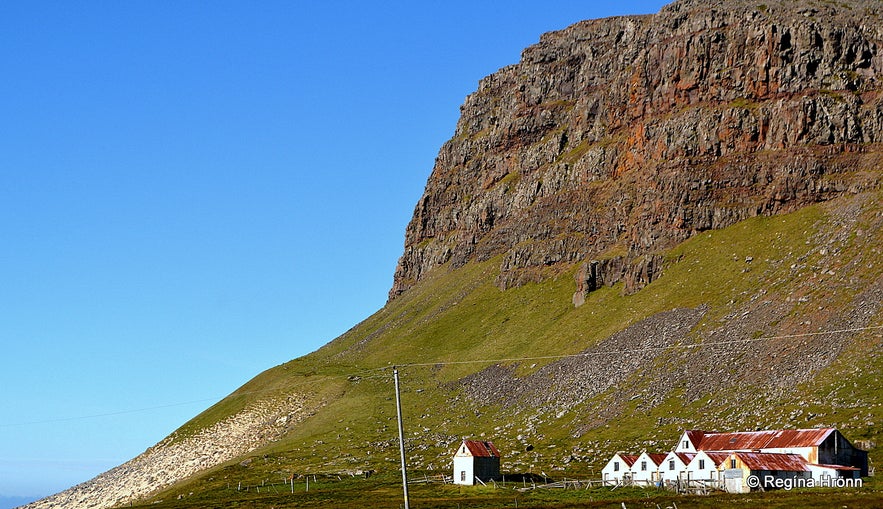
Kollsvík outhouses
The last inhabitants of Kollsvík farm left their farm back in 2002. Thus the former vibrant Kollsvík became deserted. Kollsvík is the first farm you will see on your right-hand side when you drive down from the mountain into the cove.
You will find 2 farms at Kollsvík, the farm Kollsvík (formerly called Kirkjuból), and Láginúpur, they are 2 km apart
The descendants of Össur and Sigríður at Láginúpur have maintained this beautiful area and I am grateful to them for doing so. It is a delight visiting Kollsvík.
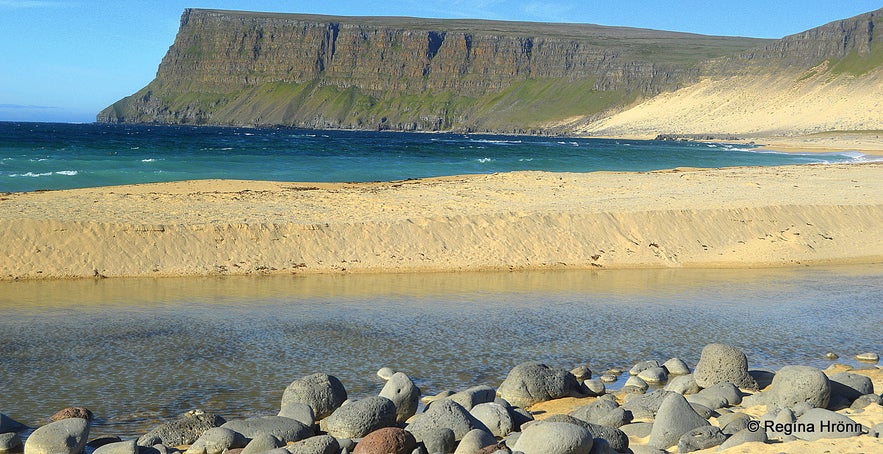
Kollsvík beach
According to the 12th chapter in Landnáma - the Book of Settlements the settler Kollur joined his blood-brother Örlygur gamli, who arrived in Patreksfjörður and lived at Örlygshöfn for the winter, which you will pass along the way to Kollsvík.
Örlygur and Kollur are thought to be the first missionaries in Iceland.
Örlygur called upon his friend, Bishop Patrick, while in danger at sea when arriving in Iceland, and that he would name the fjord after Patrick if they would be saved. Örlygur didn't settle there though, but some of his travel companions did.
Örlygur carried on and settled in Kjalarnes in southwest Iceland where his first cousin, Helgi bjóla lived.

Örlygshöfn is a lovely location which you will see on your way to Kollsvík
Örlygurss foster father, bishop Patrick from the Hebrideans, had asked him to build a church in Iceland, where he saw two mountains from the sea and a valley in each mountain, and the church was to be built under the southern mountain.
Örlygur, who had carried wood for the church-building on his ship and a church bell, built one of the first churches in Iceland at Esjuberg under the mountain Esja close to Reykjavík, according to Landnáma - the Book of Settlements, and the church is mentioned in Kjalnesingasaga in chapters 1 and 18.
I visited the outdoor memorial altar at Esjuberg a week after the altar with a 2-meter-tall Celtic stone cross was blessed by the Bishop of Iceland at summer solstice 2021.

An outdoor altar at Esjuberg in Kjalarnes in SW-Iceland where Örlygur is believed to have built his church around the year 900.
Kollur on the other hand broke his ship by Kollsvík and lived in the smallest settlement in Iceland (some 25 km²), which is most likely named after him, Kollsvík cove. There is not much that we know about Kollur, but he must have built a church in Kollsvík.
It is difficult to find old church ruins at Kollsvík, it would be lovely to find such old ruins though.
You can see church ruins of a small (12 sq.m.) early-Christianity church in Hjaltadalur in my travel-blog about Hólar in Hjaltadalur. That church is believed to have been built in 984.
I include myself in these photos so that you have a comparison.

Inside the church ruins at Efri-Ás in Hjaltadalur North-Iceland
Kollur is believed to have settled in Kollsvík before 880, long before Christianity was adopted in Iceland in 1000, but many of the Irish people, who arrived in Iceland, were Christians. And there were some Irish monks, Papar, in Iceland when the Vikings arrived.
Auður djúpúðga, the noted settler woman was Christian and erected a cross on Krosshólaborg in West Iceland. You can see a memorial stone cross for Auður at Krossaborg.
She was also Örlygur's first cousin, the sister of Helgi, but their fathers were brothers.
Kollur wrecked his ship by Kollsvík and the same happened to Auður djúpúðga when she arrived in South Iceland. She wrecked her ship in South Iceland.

In strong wind at Krosshólaborg in West Iceland
Auður managed to reach her brother Helgi bjóla in Kjalarnes with her companions, but he could only take in half of her group, so she went to Snæfellsnes in West Iceland, to her brother Björn austræni in Bjarnarhöfn, who took in the whole group.
She then settled her own land and lived at Hvammur in Dalir and her group settled in various places in this area as Laxdæla Saga tells us.
In her group was another Kollur, who got the name Dala-Kollur after he settled in Laxárdalur valley in West Iceland, and a great part of Laxdæla Saga and Njála tells us about his descendants.

Kollsvík
Many ancient place names date back to the settlers of Iceland.
And, many ancient place names in the Westfjords were given by the settlers; the bishop Patrekur = Patreksfjörður, Örlygur = Örlygshöfn, and Kollur = Kollsvík.
That is why I love reading Landnámabók and the Icelandic Sagas, as they tell us so much about the ancient place names.
We spent a couple of hours exploring Kollsvík and reading all the information signs. And we very much enjoyed being on the pink beach :)
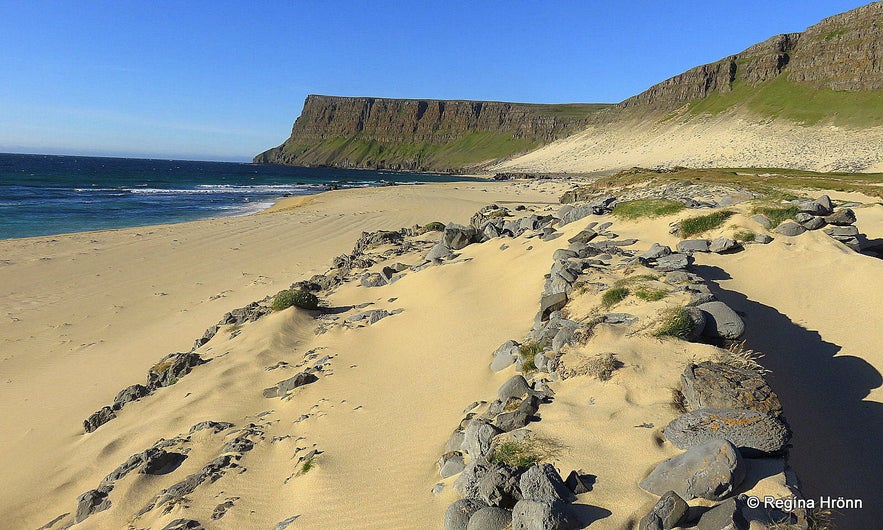
Beautiful Kollsvík beach
We then went searching for the oldest turf outhouse in Iceland, which we had heard about before our visit to Kollsvík.
And, I stopped by this huge rock and wondered if it might be an elf-rock, i.e. a rock where the hidden people (huldufólk) of Iceland might be residing.
There are many, many stories about the hidden people of Iceland living in rocks and their encounters with us mere humans. I have told you many such stories in my travel-blogs.
I found some information about this rock on the website of Kollsvík. It is called Strýtusteinn or Peaked rock, located in Brunnsbrekka slope. It is believed to be the dwellings of the hidden people of Iceland.

Strýtusteinn rock - dwellings of the hidden people
There is no folklore connected to Strýtusteinn rock that we know of, but Valdimar Össurarson at Láginúpur farm, told me that the children of Kollsvík were forbidden to climb on this rock and racket by the rock was also forbidden.
The children were told that hidden people lived in Strýtusteinn rock and that they were invisible, but apart from that, they were like us (i.e. humans). And that if they would climb on the rock or make loud noises it would anger the inhabitants of the rock.
This is customary behaviour by such rocks. When I visit the dwellings of the hidden people or their churches I always ask for permission to go closer and take photos. Respect is the keyword here.
And if you see some trash lying around by the dwellings of the hidden people, please pick it up.

The sheepcote by Strýtusteinn rock
The sheepcote by Strýtusteinn rock was back then still in use and extra care was taken not to call too loud when the sheep were called together and driven into the sheepcote.
Another rock is close by Strýtusteinn rock which is also believed to be the dwellings of the hidden people. And the church of the hidden people is at Stórhóll at Hnífar, Valdimar told me.
I don't have a photo of Stórhóll, but have shown you several such churches in other travel-blogs, f.ex.:
Elf-church Álfakirkja at Laugarvatnsvellir plains and
The Beautiful Elf City and Elf Church by Hotel Laki in South Iceland.

In this photo, you can see how close the sheepcote is to Strýtusteinn rock
Beneath Stórhóll is a large cave, Sandhellir, and it was believed that a tunnel went from the cave to the hill, i.e. the church of the hidden people.
Close by is Tröllkarlshellir cave, so it seems that the trolls and the hidden people get along, seeing that they can live in such close proximity.
Thank you, Valdimar, I am grateful for this information and will look for the church of the hidden people on my next visit to Kollsvík.
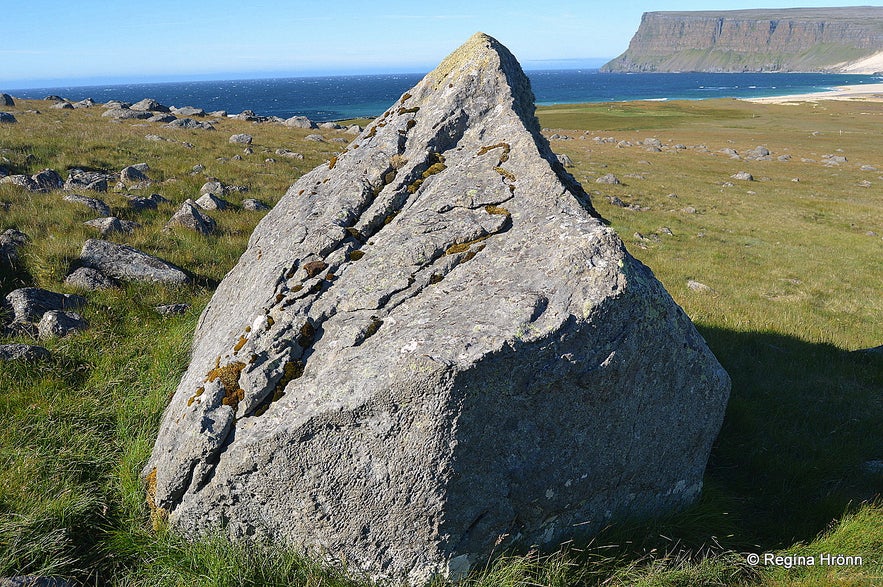
Strýtusteinn dwellings of the hidden people at Kollsvík - it is such a beautiful rock
The hidden people seemed to frequently borrow stuff from the inhabitants at Kollsvík and return the objects after they had used them.
This happened so frequently that when objects disappeared in Kollsvík, they would say that the hidden people borrowed them (ref. Kollsvík).
My family used to say the same, that if things disappeared the hidden people had borrowed them. And they were eventually returned.
So it might be in our Icelandic genes to think like this, as this is still my belief. If things go missing in my home I ask the hidden people to return them :)

Pink beaches in Kollsvík
I have written travel-blogs about other rocks of the hidden people in Iceland if you are interested to know more about them, f.ex.:
The Sheriff's Wife at Burstarfell and the Elf-Rock in East Iceland - Icelandic Folklore
Álfaborg - the City of the Elves in Borgarfjörður-Eystri in East Iceland - Icelandic Folklore and many more stories
The oldest turf outhouse in Iceland
The oldest turf outhouse in Iceland - Hesthúsið á Hólum in Kollsvík
By now we had arrived at the turf outhouse. It is most likely the oldest turf outhouse in Iceland, dating back to 1650 - it is the same age as the Taj Mahal!
At least the sign says so and I don't know of an older turf outhouse in Iceland than this one.
This little turf outhouse is called Hesthúsið á Hólum or the Stable at Hólar.
Hólar was the name of the farm in Kollsvík which was only inhabited for some 50+ years and was abandoned after the smallpox pandemic in 1707.

Inside the oldest turf outhouse in Iceland - Hesthúsið á Hólum in Kollsvík
After Hólar farm was abandoned Láginúpur farm used this little turf outhouse for 300 years as a stable in the wintertime and a stall in the summertime.
And, from 1944 this turf outhouse was used as a smokehouse for meat and male lumpfish (information from the information sign).
In 2010-2016 the farmers rebuilt the stall (the turf houses need constant maintenance) and it is now open to visitors.
You can read more about it on the Kollsvík website - Icelandic only though - Hesthúsið á Hólum.
The turf outhouse blends in well with nature
You can see other small turf outhouses in Kollsvík, but I don't know when they were built.
I am a fan of turf houses and have written a travel-blog about all the turf houses, turf sheds, and turf outhouses I have visited on my travels in Iceland:
A List of the beautiful Icelandic Turf Houses, which I have visited on my Travels in Iceland

The sign by road 612 - take road 615 for Kollsvík
We had a lovely day in Kollsvík and I would recommend a visit to this beautiful place.
I try to show you the off-the-beaten-path and less-visited locations in my travel-blogs as well as the better-known and more popular places, and Kollsvík is for sure one of them.
Don't forget to sign the guestbook by the information sign before you leave Kollsvík :)
To reach Kollsvík cove turn from road 62 to road 612 which is the turn for the very popular Látrabjarg and Rauðasandur.
Turn right from road 612 onto road 615 leading to Hænuvík and Kollsvik coves, just after you pass (or visit) the museum Hnjótur - Minjasafn Egils Ólafssonar, which I recommend visiting.
Have a lovely time at Kollsvík in the beautiful Westfjords :)
Ref.





